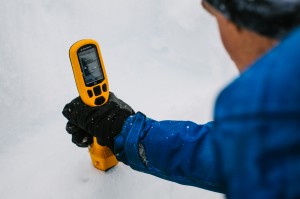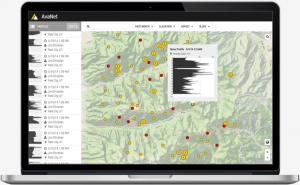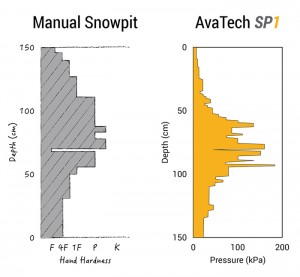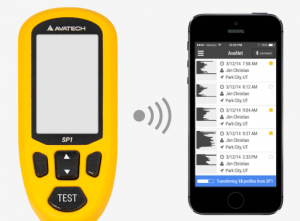This isn’t completely new technology, a similar type probe exists in Switzerland for a cool $80,000. That price prevents widespread adoption. At roughly 1/40th the cost, AvaTech’s SP-1 is almost certain to be more widely used.
Sharing the info on AvaNet™
That’s part one of AvaTech’s first product. The second part is the AvaNet™ cloud where this data can then be uploaded to a subscriber based network that will store information from around the globe. Again, this sharing of information is not new. InfoX is Canada’s national database of avalanche information of which snowprofiles are one component that is used to help avalanche pros base their decisions, whether they’re forecasters for a destination like Rogers Pass, or guides with a heliski operation. Plus there are apps like SnowPilot that exist for documenting snow profiles in the field with a smart phone. AvaTech’s difference is the scale to which snow profiles can be expanded.“I can’t dig twenty holes in a day, but I can certainly take twenty probe profiles,” states Brian Lazar, deputy director for the Colorado Avalanche Information Center. “So if I have that knowledge and I want to track a weak layer throughout different elevations, across different aspects or over time, I can use the SP1 to confirm the presence or absence of weak layers, which provides a much better understanding of how widespread a particular problem may be.”
This begs two questions. First, is the data accurate? Does it deliver the same results as those derived drawn by hand? A quick look at the sample pit data shown on AvaTech’s home pages shows there is some deviation from what an experienced avalanche pro would draw from a snowpit. This isn’t unexpected, in fact it is clear the data has a higher resolution relative to depth/position, but is it close enough, or too much?The head of Utah’s Avalanche Forecast Center Bruce Tremper tested the probe last winter and wasn’t convinced the results were an improvement, but admitted, “…the software has probably improved since then.” Indeed, since the results are based on software to interpret the data the snow profiles created are bound to improve over time. With the official availability of the SP-1 system this season, AvaTech is confident the system is ready to go.
Mo’ data mo’ betta’?
Assuming the data is accurate, will the potential increase in information improve forecasts, or muddy the waters by revealing how inconsistent any snowpack is when more data can be so easily obtained.According to AvaTech’s co-founder and CEO, Brint Markle, “What we tell the pros is that it’s no substitute for experience or judgment,” Markle said. “It doesn’t make the decisions for you. But it helps make the picture more clear. Snowpack characteristics can change dramatically over small amounts of terrain. The way we evaluate snow today, with a single snow pit, we extrapolate in a sometimes faulty way that the information holds true over larger distances than we should.”
No doubt, this increased information will add insight, and in the long run, better decision making for the backcountry community as a whole. In the short term, having more locations as well as the the ability to resolve weak layers as thin as a few millimeters is bound to force adjustments as new insight is gained with that sort of resolution in the data.
At $2300 per probe, this is not a tool for recreational BC skiers. For the nerds among us, having a subscription to the data might be a worthwhile investment, especially if you truly want a better understanding of the snowpack from a remote location, independent of what the local forecasters are saying. It will be interesting to see what new apps develop from this, from predicting avalanche conditions to water runoff for agriculture and human consumption.
Ava-Tech
SP-1
MSRP: $2300
Weight:
AvaNet
Annual Subscription: $50
Related Posts:
Story on AvaTech from MITSloan newsroom





1 comment
Craig….you may or may not know that Brint skied in Alaska with Jeff Dostie and Brennan (coincidently my son and I were there that week)…of course they will an opinion about Brint and the “gadget” that he had with him……Cheers, Chet Roe